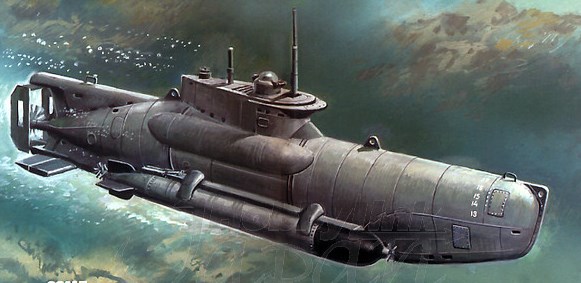The first contract for Seehund construction was placed on 30 July 1944. Enthusiasm for the submarine was so high that most of the contracts and hull numbers were allocated even before the design was completed. A total of 1,000 boats were ordered, Germaniawerft and Schichau-Werke to build 25 and 45 boats per month respectively. Other centers involved in Seehund production were CRD-Monfalcone on the Adriatic and Klockner-Humbolt-Deutz at Ulm.
However, Dönitz would not consent to the production of the Type XXVII U-boat being held up for Seehund construction, while shortages of raw material, labor and transport problems, and conflicting priorities in Germany’s economy all combined to reduce Seehund production. In the end Seehund production was undertaken by Germaniawerft at Kiel using a facility which was no longer needed for Type XXI or Type XXIII production.
A total of 285 Seehunds were constructed and allocated numbers in the range U-5501 to U-6442.
From the Allied point of view the Seehund’s small size made it almost impossible for Asdic to get a return from her hull, while her very quiet slow speed running made her almost immune to detection by hydrophone. As Admiral Sir Charles Little, Commander-in-Chief, Portsmouth put it, “Fortunately for us these damn things arrived too late in the war to do any damage”.
Seehunds operated mainly around the German coast and in the English Channel, and could attack on the surface in turbulent weather, but had to be almost stationary for submerged attacks. From January to April 1945 Seehunds performed 142 sorties, during which they sank 8 ships for a total of 17,301 tons and damaged 3 for a total of 18,384 tons; 35 Seehunds were lost in action.
The last Seehund sorties took place on 28 April and 2 May 1945, when two special missions were performed to resupply the cutoff German base at Dunkirk with rations, the boats carrying special food containers (nicknamed “butter torpedoes”) instead of torpedoes, and on the return voyage using the containers to carry mail from the Dunkirk garrison.
The French navy received four units as war damage, and commissioned them as S 621, S 622, S 623 and S624. They were used until August 1953. S 622 is preserved and on display at Brest naval museum.
The U-5075 is on display at the United States Naval Shipbuilding Museum, part of the Massachusetts Military Research Center, in Quincy, Massachusetts. Occasional amateur radio events are conducted by this museum ship, using the callsign WW2MAN.
